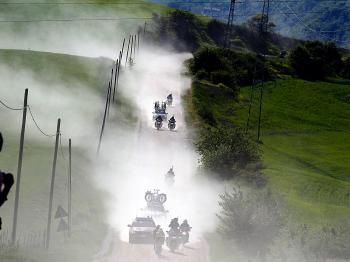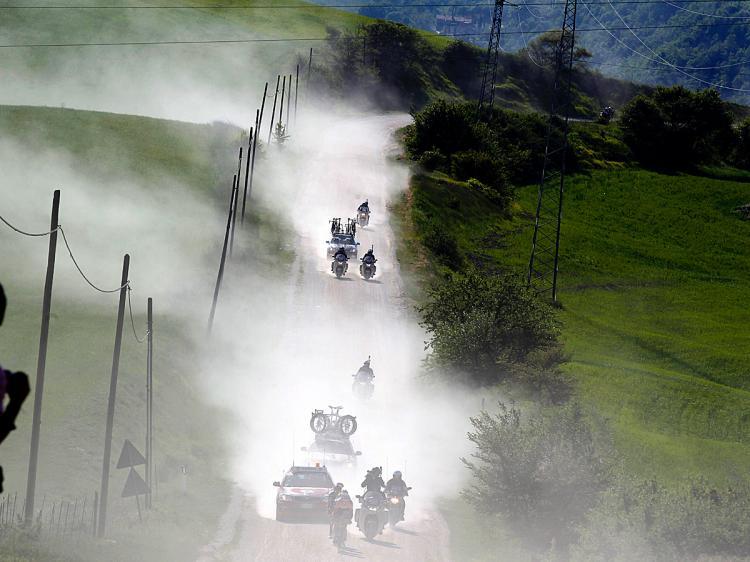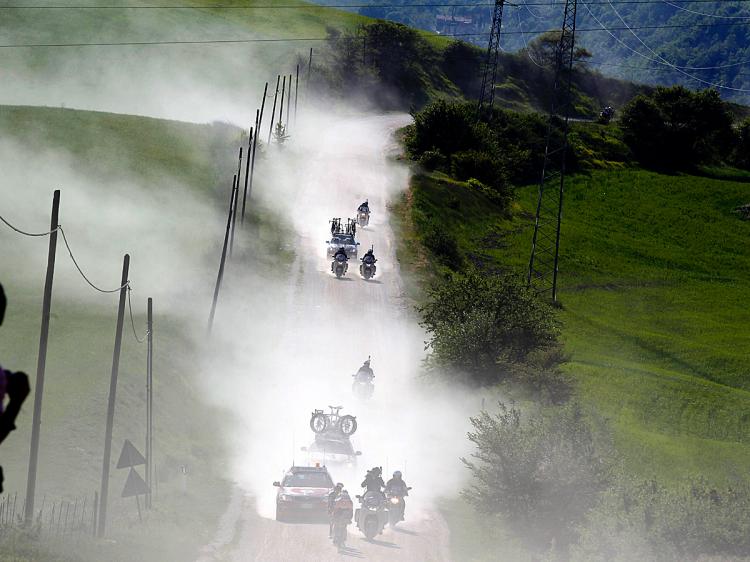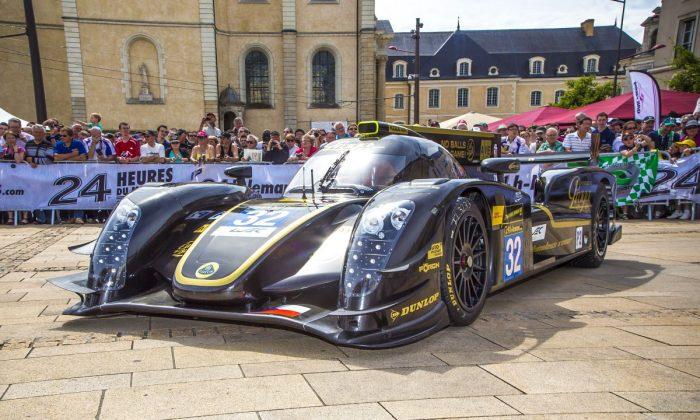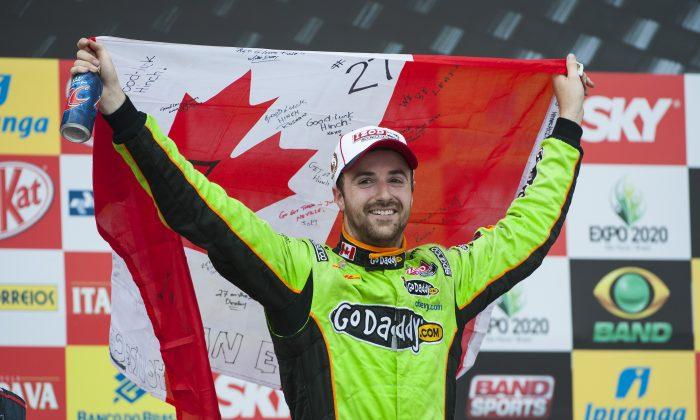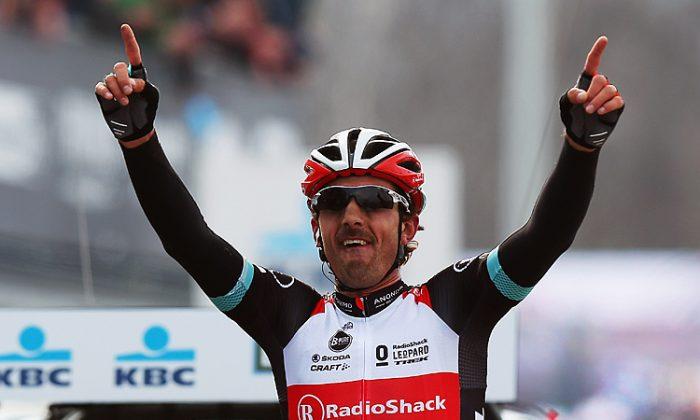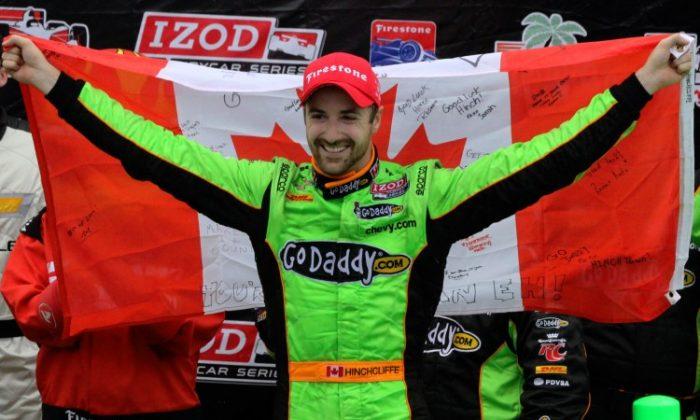“For me, this is perfect,” Weening told Eurosport. “After winning a stage in the Tour de France, this is the second biggest victory in my career. I am really happy.”
“I will try to defend the jersey as long as possible. Let’s see how far we can go. The Giro is already perfect now; I hope to keep flying high for the next two weeks.”
Wednesday’s Stage Five, with its sections of unpaved roads and its uphill finish, was the perfect anodyne for the loss of Leopard-Trek rider Wouter Weylandt in Stage Three. The chalky gravel roads demanded total concentration, and the tricky route demanded perfect strategy. Teams had to think of racing, at least for those several hours.
Garmin-Cervelo’s Tyler Farrar withdrew from the race before the stage, as did the entire Leopard-Trek team. Farrar had been Weylandt’s closest friend, and his teammates could not carry in the face of their loss.
Team captain Fabian Wegmann told cylingnews.com, “We have great respect for the Giro and its history, but we really cannot race under these circumstances. We know that we are all professional athletes but we think that this is the right thing to do.”
Leopard-Trek also set up a fund to raise money for Weylandt’s expectant wife. Details of the account, which accepts donations via Pay Pal, are here: www.cyclingnews.com/news/leopard-trek-create-donation-account-to-help-weylandts-family.
Kohler Goes Early
Several riders mentioned to the media how upset they were; one in particular, BMC rider Martin Kohler, emphasized how hard it was to keep riding after losing Weylandt.
Apparently Kohler decided the best way to get past the immediate pain was to ride as long and hard as possible. Six kilometers into the race, Kohler attacked the field, riding off into the distance at a tremendous pace. After the first hour, Kohler had nearly twelve minutes on the field.
Kohler’s lead shrank as the race progressed, but he was still six minutes ahead when he hit the first section of unpaved road. The tough surface, coupled with a steep grade, sapped his speed dramatically. It seemed the peloton, led by Roman Kreuziger’s Astana team, would ride him down easily.
Collisions and Crashes
Behind Kohler, riders were sliding and colliding in the dirt, and not just in the dirt. Earlier in the stage, race leader David Millar collided with second-place Angel Vicioso as the two contested an intermediate sprint for bonus points. Millar got back on his bike and back to the head of the peloton, but the impact and the effort to recover probably ended his reign as race leader.
There were several other small collisions, and one that proved scary; Tom-Jelte Slagter crashed and struck his head, then lay unmoving for a minute. After Monday’s tragedy, it was hard not to think the worst. Luckily, the Rabobank rider suffered only a broken eye socket.
Farnese Neri rider Francesco Failli crashed and had to withdraw. Cyril Desell and Borut Bozic, Richie Porte, Vasili Kiryienka, Chris Butler, Christiano Salerno all hit the pavement and continued.
Next: Attacks
Attacks
The dirt, the dust and the hills broke up the peloton, leaving a group of several dozen trying to catch Kohler. Roman Kreuziger led a brief attack with Stefano Gardzelli, Michele Scarponi, Vincenzo Nibali, Jackson Rodriguez and a few others but was caught. Yaroslav Popovych tried an attack, but was caught and then suffered a flat.
Up front, Kohler grimly grinded his way up the hills and fishtailed down in the dirt, but by 26 kilometers left his lead had been cut to 2:40. Rabobank’s Bram Tannink decided to attack, followed by Quick Step’s Dario Cataldo.
This pair quickly gapped the field and it seemed they would ride down Kohler and maybe take the stage. However a few kilometers down the road Cataldo crashed and Tannink lost his chain.
At the 24 km mark, AG2R’s John Gadret attacked with Rabobank’s Pieter Weening. This pair caught Kohler with ten kilometers to go; a kilometer-and-a-half later, Weening attacked, and the other two riders could not respond.
Weening, leading Gadret and Kohler, held on until the final steep ascent in the final few kilometers. Gadret and Kohler were caught two kilometers out, and Weening, though striving, was almost motionless, fighting his way up the steep grade.
This same grade cracked David Millar, who dropped back almost three minutes.
1500 meters from the line Michele Scarponi attacked, with Thomas Lövkvist and Alberto Contador marking him. A kilometer out, Weening’s lead was down to 200 meters; it seemed impossible he would hold on.
The chase leaders, taking it for granted, that they would catch Weening, focused on each other, ready to cover any attack. 400 meters out, Mikel Nieve tried an attack, but it was too late. Weening held on to win the stage by eight seconds, earning himself the [i]maglia rosa[/i] of the race leader.
Fabio Duarte of Geox took second, Jose Rodolfo Serpa of Androni Giocattoli finished third.
Kudos to Martin Kohler for a brave ride. He led for 175 km, and certainly burned away some of his emotion from the loss of Wouter Weylandt.
A bit of bemusement is directed towards David Millar. Perhaps he could not have kept the pink jersey anyway, but to crash with the second-place rider while fighting for a few bonus points … surely not the way he planned the day.
Stage Six: More Hills
Stage Six, 216 km from Orvieto to Fiuggi, is filled with rolling hills, a Cat 4 climb, and an uphill finish. Ten km to five km are uphill, and the final five km is a series of hills with a final upward slope to the line.
This should be a sprinters’ stage, barring a crazy breakaway or excessive heat, but the uphill finish could be tricky, as sprinters will have to calculate carefully when to launch. A lone attack in the final few kilometers is a real possibility.
| 2011 Giro d’Italia Stage Five Results | ||
|
| Rider (Team) | Gap |
| 1 | Pieter Weening (Rabobank) | 4:54:49 |
| 2 | Fabio Duarte (Geox-TMC) | + 0:08 |
| 3 | José Serpa (Androni) | + 0:08 |
| 4 | Christophe Le Mevel (Garmin-Cervélo) | + 0:08 |
| 5 | Oscar Gatto (Farnese Vini) | + 0:08 |
| 6 | Vincenzo Nibali (Liquigas-Cannondale) | + 0:08 |
| 7 | Alberto Contador (Saxo Bank-SunGard) | + 0:08 |
| 8 | Michele Scarponi (Lampre-ISD) | + 0:08 |
| 9 | Joaquim Rodríguez (Katusha) | + 0:08 |
| 10 | Roman Kreuziger (Astana) | + 0:08 |
| General Classification after Stage 5 | ||
|
| Rider (Team) | Gap |
| 1 | Pieter Weening (Rabobank) |
|
| 2 | Marco Pinotti (HTC-Highroad) | + 0:02 |
| 3 | Kanstantin Siutsou (HTC-Highroad) | + 0:02 |
| 4 | Christophe Le Mevel (Garmin-Cervélo) | + 0:05 |
| 5 | Pablo Lastras (Movistar Team) | + 0:22 |
| 6 | Vincenzo Nibali (Liquigas-Cannondale) | + 0:24 |
| 7 | Michele Scarponi (Lampre-ISD) | + 0:26 |
| 8 | Steven Kruijswijk (Rabobank) | + 0:28 |
| 9 | Alberto Contador (Saxo Bank-SunGard) | + 0:30 |
| 10 | José Serpa (Androni-Giocattoli) | + 0:39 |
